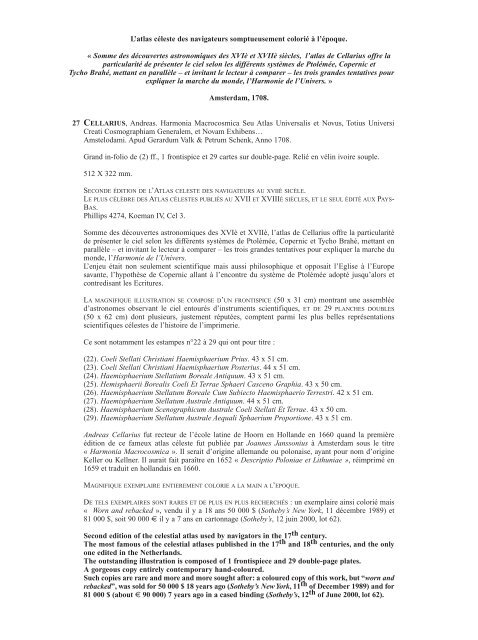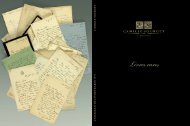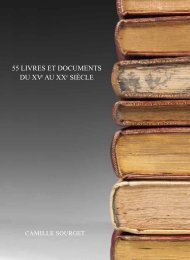CATALOGUE DE LIVRES RARES FINE BOOKS - Camille Sourget
CATALOGUE DE LIVRES RARES FINE BOOKS - Camille Sourget
CATALOGUE DE LIVRES RARES FINE BOOKS - Camille Sourget
You also want an ePaper? Increase the reach of your titles
YUMPU automatically turns print PDFs into web optimized ePapers that Google loves.
L’atlas céleste des navigateurs somptueusement colorié à l’époque.<br />
« Somme des découvertes astronomiques des XVIè et XVIIè siècles, l’atlas de Cellarius offre la<br />
particularité de présenter le ciel selon les différents systèmes de Ptolémée, Copernic et<br />
Tycho Brahé, mettant en parallèle – et invitant le lecteur à comparer – les trois grandes tentatives pour<br />
expliquer la marche du monde, l’Harmonie de l’Univers. »<br />
Amsterdam, 1708.<br />
27 CELLARIUS, Andreas. Harmonia Macrocosmica Seu Atlas Universalis et Novus, Totius Universi<br />
Creati Cosmographiam Generalem, et Novam Exhibens…<br />
Amstelodami. Apud Gerardum Valk & Petrum Schenk, Anno 1708.<br />
Grand in-folio de (2) ff., 1 frontispice et 29 cartes sur double-page. Relié en vélin ivoire souple.<br />
512 X 322 mm.<br />
SECON<strong>DE</strong> ÉDITION <strong>DE</strong> L’ATLAS CELESTE <strong>DE</strong>S NAVIGATEURS AU XVIIÈ SICÈLE.<br />
LE PLUS CÉLÈBRE <strong>DE</strong>S ATLAS CÉLESTES PUBLIÉS AU XVII ET XVIIIÈ SIÈCLES, ET LE SEUL ÉDITÉ AUX PAYS-<br />
BAS.<br />
Phillips 4274, Koeman IV, Cel 3.<br />
Somme des découvertes astronomiques des XVIè et XVIIè, l’atlas de Cellarius offre la particularité<br />
de présenter le ciel selon les différents systèmes de Ptolémée, Copernic et Tycho Brahé, mettant en<br />
parallèle – et invitant le lecteur à comparer – les trois grandes tentatives pour expliquer la marche du<br />
monde, l’Harmonie de l’Univers.<br />
L’enjeu était non seulement scientifique mais aussi philosophique et opposait l’Eglise à l’Europe<br />
savante, l’hypothèse de Copernic allant à l’encontre du système de Ptolémée adopté jusqu’alors et<br />
contredisant les Ecritures.<br />
LA MAGNIFIQUE ILLUSTRATION SE COMPOSE D’UN FRONTISPICE (50 x 31 cm) montrant une assemblée<br />
d’astronomes observant le ciel entourés d’instruments scientifiques, ET <strong>DE</strong> 29 PLANCHES DOUBLES<br />
(50 x 62 cm) dont plusieurs, justement réputées, comptent parmi les plus belles représentations<br />
scientifiques célestes de l’histoire de l’imprimerie.<br />
Ce sont notamment les estampes n°22 à 29 qui ont pour titre :<br />
(22). Coeli Stellati Christiani Haemisphaerium Prius. 43 x 51 cm.<br />
(23). Coeli Stellati Christiani Haemisphaerium Posterius. 44 x 51 cm.<br />
(24). Haemisphaerium Stellatium Boreale Antiquum. 43 x 51 cm.<br />
(25). Hemisphaerii Borealis Coeli Et Terrae Sphaeri Casceno Graphia. 43 x 50 cm.<br />
(26). Haemisphaerium Stellatum Boreale Cum Subiecto Haemisphaerio Terrestri. 42 x 51 cm.<br />
(27). Haemisphaerium Stellatum Australe Antiquum. 44 x 51 cm.<br />
(28). Haemisphaerium Scenographicum Australe Coeli Stellati Et Terrae. 43 x 50 cm.<br />
(29). Haemisphaerium Stellatum Australe Aequali Sphaerium Proportione. 43 x 51 cm.<br />
Andreas Cellarius fut recteur de l’école latine de Hoorn en Hollande en 1660 quand la première<br />
édition de ce fameux atlas céleste fut publiée par Joannes Janssonius à Amsterdam sous le titre<br />
« Harmonia Macrocosmica ». Il serait d’origine allemande ou polonaise, ayant pour nom d’origine<br />
Keller ou Kellner. Il aurait fait paraître en 1652 « Descriptio Poloniae et Lithuniae », réimprimé en<br />
1659 et traduit en hollandais en 1660.<br />
MAGNIFIQUE EXEMPLAIRE ENTIEREMENT COLORIE A LA MAIN A L’EPOQUE.<br />
<strong>DE</strong> TELS EXEMPLAIRES SONT <strong>RARES</strong> ET <strong>DE</strong> PLUS EN PLUS RECHERCHÉS : un exemplaire ainsi colorié mais<br />
« Worn and rebacked », vendu il y a 18 ans 50 000 $ (Sotheby’s New York, 11 décembre 1989) et<br />
81 000 $, soit 90 000 € il y a 7 ans en cartonnage (Sotheby’s, 12 juin 2000, lot 62).<br />
Second edition of the celestial atlas used by navigators in the 17 th century.<br />
The most famous of the celestial atlases published in the 17 th and 18 th centuries, and the only<br />
one edited in the Netherlands.<br />
The outstanding illustration is composed of 1 frontispiece and 29 double-page plates.<br />
A gorgeous copy entirely contemporary hand-coloured.<br />
Such copies are rare and more and more sought after: a coloured copy of this work, but “worn and<br />
rebacked”, was sold for 50 000 $ 18 years ago (Sotheby’s New York,11 th of December 1989) and for<br />
81 000 $ (about € 90 000) 7 years ago in a cased binding (Sotheby’s,12 th of June 2000, lot 62).





